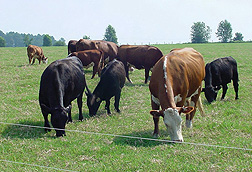| Read the magazine story to find out more. |
|
|
|
|
Finding the Best Fertilizer Recipe for Southeast's Forage Grass
By Dennis O'Brien
October 19, 2016
Trying to decide how much fertilizer to use in fields producing forage grasses is a challenge.
Forage grasses often do best with nitrogen, phosphorus and potassium fertilizers. But increasing one can reduce the impact of the others. Producers sometimes apply more fertilizer than needed, which wastes money, causes excessive runoff, and harms the environment.
By studying the effects of nutrients applied at different rates, a U.S. Department of Agriculture (USDA) scientist in Georgia developed a formula for optimally fertilizing fields used to produce forage grass in southeastern United States. The improved formula should curb runoff and reduce costs for beef and dairy producers in the Southeast who raise their own forage.
William F. Anderson and his colleagues with the Agricultural Research Service (ARS) in Tifton fertilized a commonly used forage grass at six different application rates for nitrogen fertilizer and at three different rates for the phosphorus and potassium fertilizers. They chose Tifton 85 as the forage in their study because it's a type of bermudagrass produced on millions of acres from Texas to the Carolinas and to Florida. Current fertilizer recommendations for Tifton 85 are based on outdated studies conducted for other types of bermudagrass.
The researchers used fields with two soil types common in the Southeast, kept track of rainfall amounts, and evaluated yields and the hay's nutritional value (crude protein levels) for each application rate. They also tracked fuel and fertilizer costs and market prices for the hay to calculate application rates most likely to return the highest profits.
They found the optimal application rate of nitrogen fertilizer was about 300 to 400 pounds per acre, roughly the mid- to low-range of the application rates evaluated. The results also showed that a 4-1-5 ratio of nitrogen-phosphorus-potassium works best for maximizing profits, assuming typical rainfall patterns. In other words, for every four parts of nitrogen applied, growers should apply one part phosphorus and five parts potassium.
At those rates, a field will produce about 8 to 10 tons of hay per acre, assuming typical rainfall. Results were published in May 2016 in Agronomy Journal.
Read more about this research in the October 2016 AgResearch magazine.
ARS is USDA's chief in-house scientific research agency.

